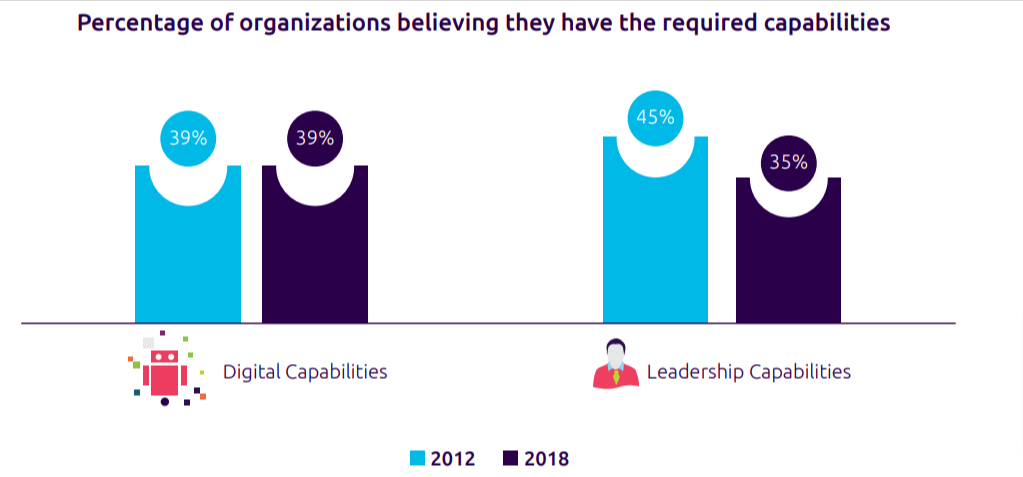Workplace dynamics are rapidly evolving. And a lot of businesses are having trouble keeping up with the rate of that evolution. It takes a lot of effort and money to update business practices, technologies, and processes. But the most important thing of all is to keep employees performing at their best. The inability of a company’s workforce to adapt to changes in business operations gives a space for rivals to gain an advantage. That’s where workforce transformation comes to the rescue.
84% of businesses think that workplace transformation enhances productivity and customer experience. However, there are certain challenges to it.
In this blog, we’ll discuss the strategic challenges of workforce transformation and how to fix it.
What is Workforce Transformation?
Workforce transformation is the process of changing how people operate and communicate within a company. It involves using new technologies, procedures, and strategies to enhance productivity and efficiency.
Transformations in job responsibilities, operations, or even entire departments, maybe a part of this change.
Understanding the workforce’s technological requirements is the first step in a holistic workforce transformation strategy. It also employs a human-centered design methodology. This covers how employees engage with operational platforms and how they connect and communicate with coworkers. It also covers how they access data from throughout the company.
Benefits of Workforce Transformation
Organizations can reap significant benefits by modernizing their workforce. Here are the top advantages of workforce transformation.
Higher Productivity
New techniques and technology that boost productivity and effectiveness might be advantageous to employees. This, in turn, can increase the overall productivity of the organization.
Enhanced Employee Engagement
Employee engagement and motivation are more likely to increase in a transformed workforce. When employees feel more appreciated and part of the company, it can increase their job satisfaction.
Enhanced Innovation
Employees may have access to new resources and tools during a workforce transition that will help them think creatively. This may result in more creative approaches to business issues and enhanced customer support.
Cost Reduction
Process automation and increased productivity from a transformed workforce can result in significant cost savings.
Therefore, firms can save money by investing in employee transformation services. It can lower the need to acquire new employees and replace existing ones.
Greater Flexibility
Increased flexibility in terms of working hours and locations might be advantageous to employees. This can result in more family time, less stress, and a better work-life balance.
Lowers Risk and Enhances Collaboration
A transformed workforce might make it easier for team members to interact and exchange ideas.
By giving users more control over operations, it can also aid in risk reduction. Employees will be more prepared to adapt to shifting client expectations thanks to this.
Strategic Workforce Transformation Challenges and How to Fix It
Workforce transformation is a crucial business concern. Every employee in the company faces difficulties relating to the workforce transformation strategy. It can be related to managing expenses, generating results, or just figuring out who is required for the job at hand and where to locate them.
Businesses operate in cutthroat competition. To meet the varying and increasingly urgent needs of their environments, they must make the most of their human resources. Sadly, the conventional recruitment and extended workforce (non-employees) management strategies lack the flexibility to keep up with demand.
Let’s take a look at the strategic workforce transformation challenges below:
1. Fragmented Sourcing
When organizations plan to secure the necessary workers or resources, they often start with a fixed idea of the type of worker they want. For example, a business leader might say, “I need a contractor” for a specific task, “We require a consultant” to support a new project, or “Let’s hire an employee” to fill a recent vacancy.
This predetermined mindset limits their approach to only one workforce transformation strategy. Consequently, they focus solely on finding a contractor, consultant, or employee through separate talent acquisition processes. Unfortunately, this approach excludes considering hybrid or extended workforce options and overlooks the potential for automation.
The Fix: When considering workforce needs, start by asking, “What are we trying to achieve?” Then explore the different ways the work can be accomplished. Instead of focusing on predetermined job roles, concentrate on the required skills and capabilities. Kasmo, with its specialized workforce hiring skills will help bridge the gap between different types of skilled resource requirements and helps foster a more effective workforce transformation strategy.
2. The Struggles of Talent Acquisition
The traditional talent acquisition models have struggled to provide organizations with the flexibility and agility they need. In-house teams often face challenges beyond their control, like fluctuating resources and demand, leading to slow talent acquisition. Although technology innovations hold promise in addressing these issues, there are practical hurdles in implementing these technologies, creating potential barriers to progress.
One of the main obstacles to achieving a more agile talent acquisition model is the diverse hiring needs and recruiting channels for each skill, role, and location covered by an organization. With numerous skills across various fields, talent acquisition must possess specialized knowledge and networks to find and engage the right talent effectively.
Additionally, the organization must have the technology infrastructure to ensure a seamless and transparent candidate experience, while also supporting the recruiters and talent decision-makers in their processes, which involves challenges in data utilization, recruitment marketing, interviewing, selection, assessment, and candidate care.
The Fix: Kasmo’s scalable workforce solution presents a practical answer to talent acquisition challenges, granting businesses the flexibility and adaptability required to address shifting demands effectively. This innovative approach enables companies to rapidly expand or shrink their workforce as needed, minimizing recruitment time and expenses. By harnessing cutting-edge technologies such as AI and remote work options, Kasmo taps into a diverse global talent pool, enriching skill sets and fostering inclusivity. Through this solution, organizations can readily access qualified talent, ensuring they retain a competitive edge in today’s dynamic and ever-changing job market.
3. Lack of Mastering Digital Capabilities at Speed
Digital capabilities are the ways in which a corporation uses technology to alter how it engages with customers, runs internal operations, or defines its business model.
Today, 39% of organizations claim to have the necessary digital capabilities, which is the same percentage as in 2012.
The rising complexity of technology and implementation issues seem to be impeding organizations’ ability to improve operations. The movement in collaboration tools and capabilities may indicate that workers enthusiastically adopted tools and platforms at first but stopped using them. Furthermore, even among top executives who are already under time constraints, availability does not guarantee real use.
The Fix: If you’re eager to initiate a transformative journey but lack the necessary expertise, Kasmo’s Build-Operate-Transfer (BOT) model is the perfect solution. At its heart, this model revolves around transferring essential capabilities to your organization, empowering you to thrive independently. From day one, Kasmo works collaboratively alongside your teams, fostering the development of digital capabilities and maximizing operational efficiency.
4. The Challenge of Managing the Extended Workforce
Fluctuations in workforce supply and demand extend beyond employee recruitment. This makes it challenging for procurement to have full visibility into the extended workforce. While procurement aims to manage the nonemployee workforce to control costs, many organizations experience increased overall expenses. The non-permanent workforce can be broadly categorized into two groups:
- Temporary/Contingent Workforce: Engaged under time-and-materials arrangements and managed daily by the client organization. Typically, these workers fall under a managed service provider (MSP) arrangement, offering clear visibility into pay rates, time worked, and supplier margins.
- Consultant/SOW Workforce: Engaged under milestone or time-and-materials arrangements, with a third party (e.g., a consultancy) partially responsible for service delivery. This group is usually engaged through statements of work (SOWs) negotiated by procurement, resulting in less transparent and structured data with higher margins.
The extended workforce paradox arises from the fact that it is easier to reduce costs by focusing on the contingent workforce. By consolidating various engagement paths, such as streamlining staffing firm relationships and centralizing work payments, organizations can implement a common, consistent management process.
Often, an external MSP partner takes charge of this process, leading to improved data visibility, governance, and cost control. This approach helps identify and address cost inconsistencies by bringing discipline to pricing and supplier utilization throughout the extended workforce supply chain.
The Fix: To prevent uncontrolled spending and ensure better cost control and compliance, consider adopting a unified approach for all resource types. Instead of managing employee recruitment, contingent workforce, and services separately, integrate them under a single framework with the help of a specialized service provider like Kasmo. By centralizing and standardizing the process, you can effectively manage and optimize your workforce expenditure.
Key Takeaway
In conclusion, addressing the challenges of workforce transformation requires a forward-thinking approach. Contingent workforce solutions offer a promising way forward.
Embracing contingent workforce solutions unlocks the potential for a more agile, efficient, and future-ready organization, capable of navigating the complexities of today’s workforce challenges with confidence.
Ready to transform your workforce and overcome strategic challenges? Contact the team at Kasmo. We will help you embark on a transformative journey toward building a dynamic and resilient workforce.


